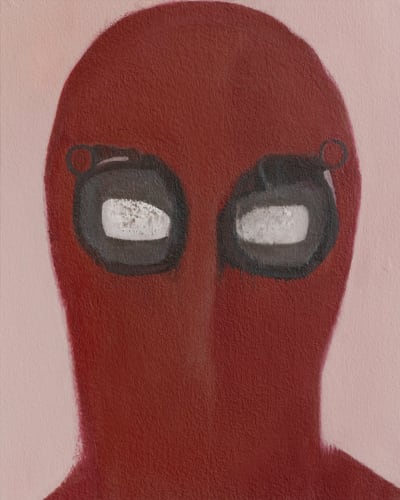“I. Spatial relationship has been a continuous thread in Han Bing’s painting practice. In works c. 2013, physical and architectural spaces bear the weight of the artist’s visual expression. In Bush (2013), an outdoor tree is inserted into the interior of a modernist house; Meeting (2013) depicts a domed room converted into a deep dry well; and, in Landscape #5 (2014), a floating billboard of landscape, like the backdrop for a play, is suspended above a pink stage. With these works, Han Bing wanders along the fine line between fiction and nonfiction. She examines and imagines an unusual quotidian reality using painterly thoughts.
In Ball Room (2015), muted depiction of human figures contributes to Han Bing’s exploration of spatial relationships. The crowd in, presumably, tuxedos and gowns appear no different than the crystal chandeliers, stairs, or curtains in the background. Thick layers outline shapes, conveying specific objects and figures; but none of this is the subject of this work. The subject is encapsulated in the three bars of colors – white, gray, and deep red – placed high and centered in the painting. The bars are short and clear-cut, and contrast with the rest of the jagged images that resemble visuals from a distorted television screen. With this work, Han Bing seems to be confronting a contemporary dilemma: In an era during which images and symbols saturate reality, how can a painter trust their authenticity on the canvas? Perhaps, at the time she created this piece, for her, the straight-forward bars of color served as a refined extraction of shapes, but also a basic unit she could trust to measure reality.
II.Han Bing soon started to fight against this dilemma, and fortunately, she was not devoured by this beast-like reality that is so occupied with an excess of images. On the contrary, she strove to identify its chaotic nature and portray the folds and particles within it.
In a group of works represented by East Wave (2017), Han Bing used photos she took of street posters and subway advertisements in various cities. She noticed these ready-made images that had been torn apart in many iterations, and then translated the misplaced, ripped-apart, and then adhered parts onto her canvas. In East Wave, the artist created at least three layers of images: first, a large area of yellow with white-edge slices sits in the foreground, almost appearing as a yellow iceberg; next, a layer of faint blue and red creates a haze, haunting the background behind the bold yellow shards; at the bottom, a plain grayish-white with creases and neat borderline suggests a darker background lurks below the whitish surface. It seems as if the image’s most relevant parts have been sliced off in large chunks. The gaps, holes, and fragments give off the feeling of an abandoned image as an object.
Other works in the series, such as Double Screen (2016) and Overlap (2017), include complex layers of images, dazzling the eye to the extent that it is difficult to clarify the elements. The eye experiences a journey full of rhythms while moving around these images, just like a melody with peaks and valleys – along the white edges lie the staggered residuals of fragmented images; some parts are dense like drum beats, some graffiti sprays a line of rap, and some comet-tail-shapes the ending notes with a gradual-weakening effect. The materialized and invalidated images are reborn on Han Bing’s canvas. She cherishes the previous life of these images, tracing back the process of separation between an image and the information it carried, and keeps the glue marks, curly edges, uneven wrinkles, and torn and broken remains. She replaces the original images to allow a new one to emerge.
For Han Bing, the creation process is an anti-symbolic one. It is also the reality that Han Bing gives to her painting. She deconstructs all sorts of purposeful images in real life, and these resulting images construct new patterns, rather than new semiotics. In the titles of some works, places like New York City’s Mott Street, Canal Street, and Downtown LA are mentioned. They hint at the existence of spatial relationships in a traditional sense. But just as the images are stripped of meaning, the reference to specific locations has nothing to do with geopolitical critiques; rather, the geographical information is an archiving method for the newborn patterns.”

